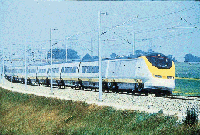|
Electromagnetic fields in the environment
18/06/2013
Radar
Radars are used for navigation, weather forecasting, and military applications, as well as a variety of other functions. They emit pulsed microwave signals. The peak power in the pulse can be high even though the average power may be low. Many radars rotate or move up and down; this reduces the mean power density to which the public is exposed in the vicinity of radars. Even high power, non-rotating military radars limit exposures to below guideline levels at locations of public access. Security systems Anti-theft systems in shops use tags that are detected by electrical coils at the exits. When a purchase is made the tags are removed or permanently deactivated. The electromagnetic fields from the coils do not generally exceed exposure guideline levels. Access control systems work in the same way with the tag incorporated into a key ring or identity card. Library security systems use tags that can be deactivated when a book is borrowed and reactivated when it is returned. Metal detectors and airport security systems set up a strong magnetic field of up to 100 μT that is disturbed by the presence of a metal object. Close to the frame of the detector, magnetic field strengths may approach and occasionally exceed guideline levels. However, this does not constitute a health hazard, as will be discussed in the section on guidelines. (see Are exposures above the guidelines harmful?)  Electric trains and trams Long-distance trains have one or more engine cars that are separate from the passenger cars. Thus passenger exposure comes mainly from the electricity supply to the train. Magnetic fields in the passenger cars of long-distance trains can be several hundred μT near the floor, with lower values (tens of μT) elsewhere in the compartment. Electric field strengths may reach 300 V/m. People living in the vicinity of railway lines may encounter magnetic fields from the overhead supply which, depending on the country, may be comparable to the fields produced by high-voltage power lines.  Motors and traction equipment of trains and trams are normally located underneath the floors of passenger cars. At floor level, magnetic field intensities may amount to tens of μT in regions of the floor just above the motor. The fields fall off quickly with distance from the floor, and exposure of the upper bodies of passengers is much lower. TV and radio When choosing a radio station on your stereo at home, have you ever wondered what the familiar abbreviations AM and FM stand for? Radio signals are described as amplitude-modulated (AM) or frequency-modulated (FM) depending on the way in which they carry information. AM radio signals can be used for broadcasting over very long distances whereas FM waves cover more localized areas but can give a better sound quality.AM radio signals are transmitted via large arrays of antennas, which can be tens of metres high, on sites which are off-limits to the public. Exposures very close to antennas and feed cables can be high, but these would affect maintenance workers rather than the general public. TV and FM radioantennas are much smaller than AM radio antennas and are mounted in arrays at the top of high towers. The towers themselves serve only as supporting structures. As exposures near the foot of these towe Table of contents
|
|
©ESMMC 2013 ESMMC including ESMMC Asia,ESMMC Europe,ESMMC America,ESMMC Africa,ESMMC Oceania.

